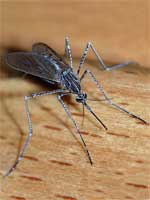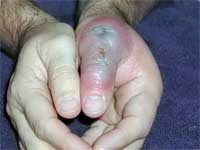Dangerous Creatures
Belize is home of many dangerous Creatures. Smaller animals actually
present more of a threat to humans than large
animals. To compensate for their size, nature has given many small
animals weapons such as fangs and stingers to defend themselves. These
are the animals you are more likely to meet as you unwittingly
move into their habitat, or they slip into your environment unnoticed.
Keeping a level head and an awareness of your surroundings will keep
you alive if you use a few simple safety procedures. Do not let
curiosity and carelessness kill or injure you.
Black
Widow Spider
Black Widow Spiders
are extremely poisonous arachnids (not insects). Their
venom is 15 times as poisonous as the venom of the prairie rattlesnake.
These venomous spiders
are found in warm and temperate climates all around the world. They
live in dark places, in drain pipes, under logs and rocks.
|
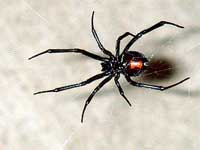
Latrodectus hesperus
|
Bullet Ant
Paraponera, the
so-called bullet ant (P. clavata), named on account of its powerful and
potent sting, which is said to be as painful as being shot with a
bullet. It is called by the locals "Hormiga Veinticuatro" or "24-hour
ant", from the 24 hours of pain that follow a stinging.
|
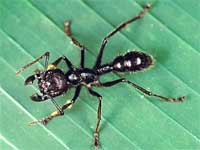
Paraponera
|
Workers
are 18-25 mm long and look like stout, reddish-black, wingless
wasps. The pain caused by this insect's sting is purported to be
greater than
that of any other Hymenopteran, and is ranked as the most painful. It
is described as causing "waves of burning, throbbing, all-consuming
pain that continues unabated for up to 24 hours".
|
Brown
Recluse Spider
As
indicated by its name, this spider is not aggressive and
usually bites only when pressed against the skin, such as when tangled
up
within clothes, bath towels, or in bedding. A minority of brown recluse
spider
bites form a necrotizing ulcer that destroys soft tissue and may take
months to
heal, leaving deep scars. The damaged tissue will become gangrenous and
eventually slough away. The initial bite frequently cannot be felt and
there
may be no pain, but over time the wound may grow to as large as 10
inches (25
cm) in extreme cases. Bites usually become painful and itchy within 2
to 8
hours; pain and other local effects worsen 12 to 36 hours after the
bite with
the necrosis developing over the next few day.
|
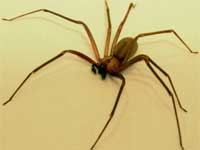
Loxosceles reclusa
Size, max. one Belize $ Coin
The Bite
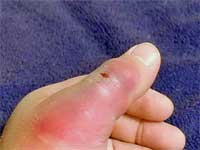 Day 5
Day 5
|
|
Day 6
|
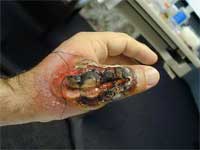
Day 10
|
|
Central Amer.
Coral Snake
The mild tempered
Central American coral snake is
probably the most common coral snake that is found in Belize.
Unlike vipers that strike with their fangs, coral snakes bite their
prey and they have to almost use a chewing motion to inject appropriate
amounts of strong neurotoxic venom.
|
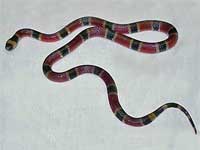
Micrurus
nigrocinctus
Size, max. 3
feet
/ 100cm
|
Dart
Frog
The bright
coloration of the poison dart frog serves as a warning to potential
predators that it is one of the most poisonous animals on earth. Most
poison dart frogs have brightly colored skin which is used as a
warning sign to predators. These frogs can be very small, ranging from
one to 6 cm in length, depending on the age, sex, and species of the
frog.
From tiny
pores in its skin, the frog secretes a defensive toxin that makes it
unpalatable to curious predators and which could easily kill if
injected into a
human or other animal. "Even a very small amount of the batrachotoxin
found in the skins of the
Golden Poison Dart Frog and at least two other species of Phyllobates
frogs
- on the order of just 40 micrograms - can be fatal"
|
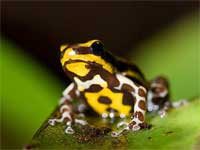
Dendrobatidae
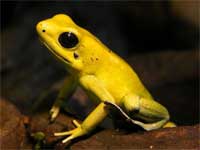
Phyllobates
terribilis
|
Eyelash Palm
Pitviper
This
viper is a typical
ambush predator, lying in patient wait for unsuspecting prey to wander
by. This tree dwelling snake is a nocturnal hunter and not
aggressive. The Eyelash Palm Pitviper has a strong hemotoxic venom. It
has two
eyelash-like pointed scales above each eye, its coloration varying
between golden-yellow, green, olive green, brown, grayish-brown, with
blotches or cross bands in various colors.
|
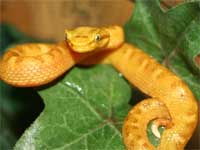
Bothriechis
schlegelii
Size, max. 2,5 feet / 80 cm
|
Fer-de-Lance
The Yellow-jawed-Tommygoff are sensibly feared throughout Central
America. Also called "Yellowjaw" or "Tommy
Goff" by Belizeans. These snakes They have a strong, fast acting
hemotoxic venom, they are
fairly common, are hard to see, and they will strike if perturbed.
This is an aggressive snake, so be weary. His
bite (although responsible for the majority of snake bite deaths in the
region) is rarely fatal. Although he is a very grumpy snake who doesn't
tend to run away and will stand his ground and attack when disturbed,
he is also quite smart and will normally give a dry bite or only
partially envenomate the poor hapless soul that gets in the way.
The bite is designed to start the digestion
process and to make sure the prey doesn't get very far before
collapsing
|
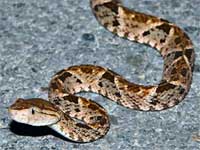
terciopelo,
fer-de-lance
Size, max. 3 feet / 90 cm
 Leg after a
untreated Bite
Leg after a
untreated Bite
|
Jumping
Pitviper
The Jumping
Pitviper, often hide's under fallen logs and
piles of leaves and can be difficult to see and also armed with a
strong hemotoxic venom. The color
of this viper’s stocky body varies from brown to gray and it has dark
brown or black dorsal blotches. It has no pattern on its head. It is a
nocturnal snake that comes out in the early evening hours to feed on
lizards, rodents, and frogs.
|
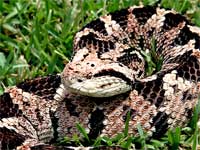
Atropoides nummifer
Size, max. 2,5 feet / 80
cm
|
Mayan
Coral Snake
This beautiful Mayan Coral Snake can be very difficult to see and her
neurotoxic venom is the most dangerous in Belize. She will move on or
under the surface, but it most likes to move under thick leaf litter.
It is usually nocturnal and feeds primarily on other snakes.
Like all coral snakes, it isn't aggressive. Unless you step on or
foolishly try to catch one, you have almost no chance of being bit by
this very deadly snake.
|
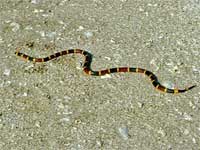
Micrurus
hippocrepis
Size, max. 2 feet / 60
cm
|
Mexican
Cantil
The Mexican Cantil
or also Mexican moccasin has a reputation for having a nasty
disposition and being
extremely dangerous. They are shy by nature, and if threatened their
first
instinct is usually to flee. If unable to flee they will threat display
by
raising their head and sometimes opening their mouth. They generally
will only
strike if given no other choice. Coloration can vary on their heavy
body, but most are brown or
black, with darker brown or black banding, sometimes with white or
cream
colored accents.
|
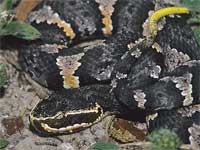
Agkistrodon bilineatus
Size, max. 4 feet
/ 140
cm
|
Neotropical
Rattlesnake
This Neotropical Rattlesnake is the only
rattlesnake found in Belize. They
can be found in swamps and feed on birds, small mammals, amphibians and
reptiles. Bites from Neotropical Rattle- snake in particular can result
in
impaired vision or complete blindness, auditory disorders, ptosis,
paralysis of the peripheral muscles, especially of the neck, which
becomes so
limp as to appear broken, and eventually life- threatening respiratory
paralysis.
|
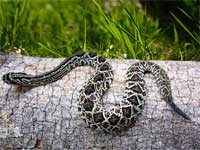
Crotalus durissus terrificus
Size, max. 5.5 feet /
180
cm
|
In Canada
their venom contains powerful neurotoxins with death resulting from
respiratory
failure. This changes gradually southward and the venom composition is
overwhelmingly hemotoxic in southern Argentina, yet the snake is
no less
deadly. This has dire implications for medical treatment, not only in
the
treatment protocol, but also the dilemma that the anti-venom may not
properly
represent the composition of the particular region.
|
Hognosed
Pitviper
The Hognose Viper
is also called the Horned Hognosed viper or Rhino Viper. The
Hognose Viper is the only snake in Belize with a
distinctly upturned snout that is at least twice as high as it is wide.
Dorsally, it is a dark snake, often with a narrow cream colored
mid-dorsal stripe. It employs a strong
hemotoxic venom to incapacitate it's prey.
|
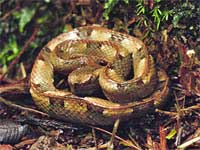
Porthidium nasutum
Size, max. 2 feet / 60
cm
|
Bats
Despite the legends, bats (Desmodus species) are
a relatively
small hazard to the survivor. There are many bat varieties worldwide,
but you find the true vampire bats only in Central and South America.
They are small, agile fliers that land on their sleeping victims,
mostly cows and horses, to lap a blood meal after biting their victim.
Bees, Wasps, and Hornets
We are all familiar with bees, wasps, and hornets. They
come in many
varieties and have a wide diversity of habits and habitats. Avoidance
is the best tactic for self-protection. Watch
out for
flowers or fruit where bees may be feeding. Nearly all honeybees in Belize are now Africanized,
except the native stingless bee.
Centipedes and Millipedes
Centipedes and millipedes are mostly small and harmless. A few
varieties of centipedes have a poisonous bite, but infection is the
greatest danger, as their sharp claws dig in and puncture the skin. To
prevent skin punctures, brush them off in the direction they are
traveling, if you find them crawling on your skin
Snakes
Nearly all snakes avoid man if possible. Most snakes get out of
the way and are seldom seen. Snakes are widely distributed on Mainland
of Belize. Although venomous snakes use their venom to secure food,
they also use it for self-defense. Human accidents occur when you don't
see or hear the snake, when you step on them, or when you walk too
close to them.
Spider & Scorpions
You can find scorpions on the cayes and in on the
Mainland. They are mostly nocturnal in habit. Fatalities
from scorpion stings are rare, but they can occur in children, the
elderly, and ill persons.
In environments known to have spiders
and scorpions, check your footgear and clothing every morning. Also
check your bedding and shelter for them. Use care when turning over
rocks and logs.
Tarantulas are large, hairy spiders (Theraphosidae
and Lycosa
species) best known because they are often sold in pet stores. The bite
of a
tarantula is said to be painful but not dangerous unless you are
allergic
to the venom. If you are bitten by a tarantula and begin to experience
tightness in the chest and shortness of breath, going to a hospital
emergency
room would be a good idea.
There are several species of venomous fish and invertebrates, all of
which live in salt water. All of these are capable of injecting
poisonous venom through spines located in their fins, tentacles, or
bites. Their venoms cause intense pain and are potentially fatal. If
injured by one of these fish or invertebrates, treat the injury as for
snakebite.
Auger
Shells
The Auger Shells or
Terebra, are similar to cone shells but much thinner and longer.
They
poison in the same way as cone shells, but their venom is not as
poisonouIn some cones, the venom is powerful enough to be lethal to
collectors who are not careful in handling the mollusc. World-wide,
there are about 300 species
|
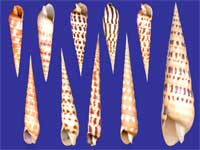
Terebridae
|
|
Cone
shells
These cone-shaped
shells have smooth, colorful mottling and
long, narrow openings in the base of the shell. They live under rocks,
in crevices and coral reefs, and along rocky shores and protected bays
in tropical areas. All have tiny teeth that are similar to hypodermic
needles. Avoid any shell
shaped like an ice cream cone.
They can inject an
extremely poisonous
venom that acts very
swiftly, causing acute pain, swelling, paralysis, blindness, and
possible death within hours. Avoid handling all cone shells. Three
species that are known killers are the Geographic Cone (Conus
geo- graphus)
the Textile Cone (Conus textile), and the Tulip Cone (Conus tulipus)
though around twenty cones are known to be dangerous to humans.
|
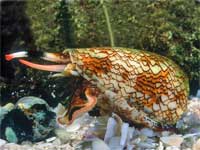
Conidae
Size, max 6" or 15 cm
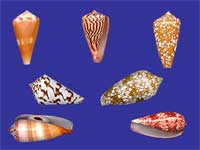 Conidae Collection
Conidae Collection
|
Fire Coral
Fire corals have a
bright yellow-green and brown skeletal covering and
are widely distributed in tropical and subtropical waters. They appear
in small brush-like growths on rocks and coral. Divers often mistake
fire coral for seaweed, and accidental contact is common.
Fire corals are colonial marine organisms that look rather like real
coral. However they are technically not corals; they are actually more
closely related to jellyfish and other stinging anemones.
|
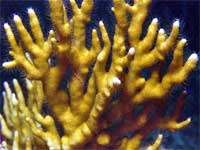
Net fire coral
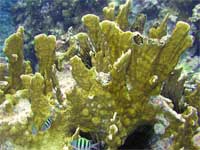
Plate fire coral
|
The very
small nematocysts on fire corals
contain tentacles that protrude from numerous surface pores (similar to
Jelly Fish stings).
In addition, fire corals have a sharp, calcified external skeleton that
can scrape the skin.
|
Portugese
man on war
Although it
resembles a jellyfish, the Portuguese man-of-war is
actually a colony of sea animals. Mainly found in tropical regions, the
Gulf stream current can carry it as far as Europe. It is also found as
far south as Australia.
The Portuguese man-of-war resembles a
large pink or purple balloon floating on the sea. The floating portion
of the man-of-war may be
as small as 15 centimeters, but the tentacles can reach 12 meters in
length. The huge tentacles
are actually colonies of stinging cells. These tentacles inflict a
painful and incapacitating sting, but
the sting is rarely fatal.
|
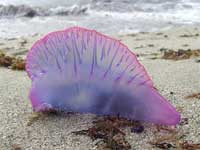
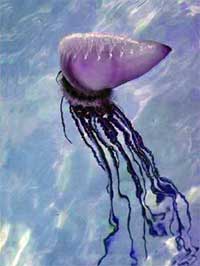
|
Scorpion
Fish or Zebra Fish
Scorpion
fish live
mainly in the reefs. They vary from 30 to 90 centimeters long, are
usually reddish
in coloration, and have long wavy fins and spines. They inflict an
intensely painful sting. Rockfish, also
referred to as scorpion fish in the tropics, are found
most often in the sand or near rocks, even where the water is shallow.
It has stingers on its head and fins.
|
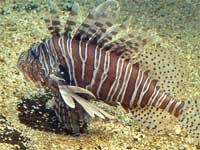
Scorpaena plumiere
|
Stone
Fish
Stonefish are found
in the tropical waters of the Pacific and Indian
oceans. Averaging about 30 centimeters in length, their subdued colors
and lumpy shape provide them with exceptional camoflauge. When stepped
on, the fins in the dorsal spine inflict an extremely painful and
sometimes fatal wound. The Stonefish is the most venomous fish in the
world.
|
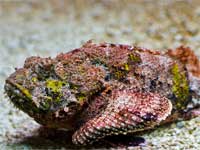
Synanceja
verrucosa
|
Surgeonfish
The Surgeonfish
or Tang is average 20 to 25 centimeters in length, with a deep
body, small mouth, and bright coloration. Named for extremely sharp and
movable spines located
on each side of their tail that are thought to resemble a
surgeonâs
scalpel, that cause extremely painful wounds.
|
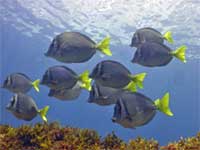
Acanthuridae
|
Toadfish
Toadfish are
between 17.5 and 25 centimeters long and have
a dull color and large mouths. Males make the nests and guard them
after the female lays the eggs.
The
male attracts the female by "singing", that is by releasing air by
contracting muscles on their swim bladder. The sound has been called a
'hum' or 'whistle'. They often hide in rock crevices, among the bottom
vegetation, or even bury themselves in the sand and may
be easily stepped on. They have very sharp, extremely poisonous spines
on the dorsal fin (back).
|
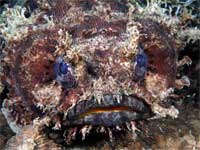
Batrachoididae
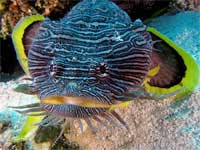
Batrachoididae
|
Jellyfish
Jellyfish-related deaths are rare, but the sting they
inflict is extremely painful. Most known deaths from
jellyfish are attributed to the man-of-war. Other jellyfish can inflict
very painful stings as well. Avoid the long tentacles of any jellyfish,
even those washed up on the beach and apparently dead.
Stingrays
Stingrays (Dasyatidae species) are a real hazard in shallow
waters, especially tropical waters. The type of bottom appears to be
irrelevant. There is a great variance between species, but all have a
sharp spike in their tail that may be venomous and can cause extremely
painful wounds if stepped on. All rays have a typical shape that
resembles a kite. You find them along the coasts of the Americas,
Africa, and Australasia.
|
 |
|
